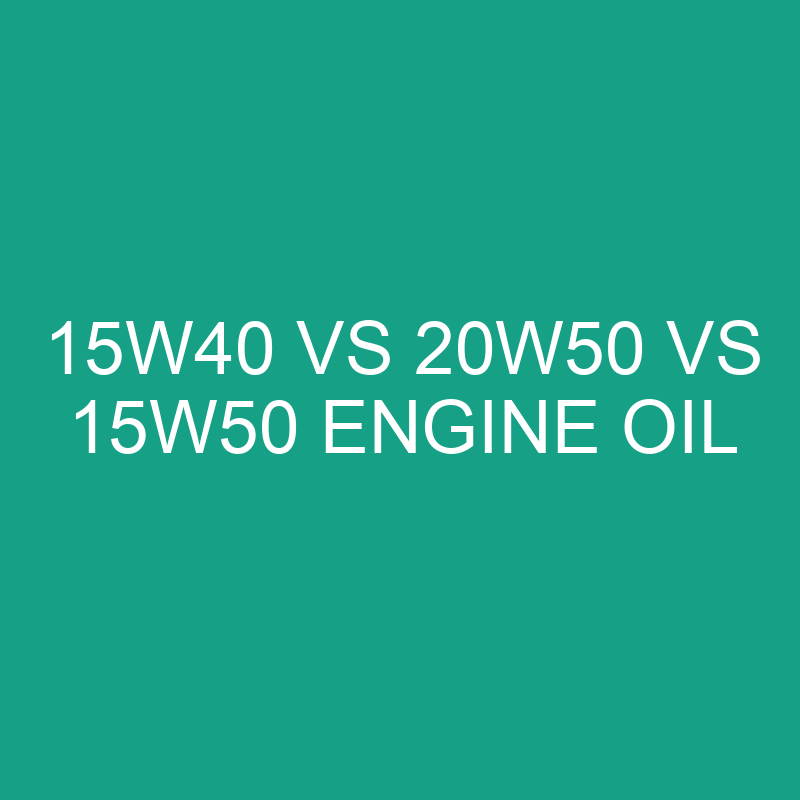Unraveling the Nuances: 15W-40 vs. 20W-50 vs. 15W-50 Engine Oils
Motor oil plays a vital role in maintaining the health and performance of an engine, and the choice between different viscosities can significantly impact how well an engine operates. In this comprehensive article, we will explore the distinctions between three common engine oil grades: 15W-40, 20W-50, and 15W-50. Understanding these differences is crucial for vehicle owners looking to make informed decisions about the lubrication of their engines.
Post Contents
1. Introduction to Engine Oil:
1.1 Viscosity and Its Significance:
Viscosity, denoted by numbers like 15W-40, 20W-50, and 15W-50, is a measure of the oil’s resistance to flow. The “W” stands for winter, indicating how well the oil performs in cold temperatures. Lower viscosity numbers indicate better flow in cold conditions.
1.2 Importance of Choosing the Right Viscosity:
Choosing the right viscosity is crucial because it affects how well the oil can lubricate the engine components, especially during cold starts and high-temperature operation. Different engines have different requirements, and selecting the appropriate oil ensures optimal engine protection.
2. 15W-40 Engine Oil:
2.1 Overview:
- Cold-Weather Performance: Good cold-start protection due to the low “W” rating.
- Operating Temperature Range: Versatile and suitable for a wide range of temperatures.
- Common Use: Widespread use in various applications, including diesel engines.
2.2 Applications:
- Diesel Engines: Widely used in diesel engines, especially in heavy-duty applications.
- Gasoline Engines: Suitable for many gasoline engines, providing a balance between cold-start protection and high-temperature stability.
2.3 Advantages:
- Versatility: Suitable for diverse temperature conditions.
- Common Standard: Found as factory-fill oil in many vehicles, especially in diesel applications.
- Shared Lubrication Systems: Commonly used in engines with shared lubrication systems (engine and gearbox).
2.4 Considerations:
- Diesel Engines: Often recommended for diesel engines due to its robust formulation.
- Everyday Use: Commonly used for regular commuting and general driving conditions.
3. 20W-50 Engine Oil:
3.1 Overview:
- Cold-Weather Performance: Acceptable cold-start protection.
- Operating Temperature Range: Suited for higher temperatures; offers stability in warm climates.
- Common Choice: Often used in high-performance and older engines.
3.2 Applications:
- High-Performance Engines: Commonly used in high-performance and sports car engines.
- Older Engines: Suitable for older engines that may benefit from the higher viscosity.
3.3 Advantages:
- High-Temperature Stability: Provides stability under high-temperature conditions.
- Performance Emphasis: Often chosen for high-performance and racing applications.
- Older Engines: Can benefit older engines with looser tolerances.
3.4 Considerations:
- Performance Cars: Found in sports cars and high-performance vehicles.
- Warmer Climates: Suited for areas with warmer temperatures.
- Modified Engines: Common in engines with modifications or increased power.
4. 15W-50 Engine Oil:
4.1 Overview:
- Cold-Weather Performance: Good cold-start protection.
- High-Temperature Stability: Offers enhanced stability at high temperatures.
- Versatility: Suitable for a broad range of temperatures.
4.2 Applications:
- High-Performance Cars: Used in some high-performance and sports cars.
- All-Purpose Use: Suitable for various applications requiring a balance between cold-start and high-temperature performance.
4.3 Advantages:
- Temperature Range: Provides stability in a broad operating temperature range.
- Performance Emphasis: Formulated for engines that demand extra protection under extreme conditions.
- Versatility: Well-suited for diverse temperature conditions.
4.4 Considerations:
- Sports Cars: Found in some sports and high-performance vehicles.
- All-Season Use: Suitable for year-round driving in various climates.
- Performance Modifications: Can be beneficial for engines with modifications or increased power.
5. Comparative Analysis: 15W-40 vs. 20W-50 vs. 15W-50 Engine Oils
5.1 Cold-Weather Performance:
- 15W-40: Good cold-start protection.
- 20W-50: Acceptable cold-start protection.
- 15W-50: Good cold-start protection.
5.2 Operating Temperature Range:
- 15W-40: Versatile for a range of temperatures.
- 20W-50: Suited for higher temperatures.
- 15W-50: Suitable for a broad range of temperatures.
5.3 Versatility:
- 15W-40: Suitable for diverse temperature conditions.
- 20W-50: Suited for warmer climates.
- 15W-50: Well-suited for diverse temperature conditions.
5.4 Common Applications:
- 15W-40: Common standard for various applications, especially diesel engines.
- 20W-50: Found in high-performance and older engines.
- 15W-50: Used in high-performance and sports car engines.
5.5 Performance Emphasis:
- 15W-40: Balanced performance for general use.
- 20W-50: Emphasis on high-temperature stability and performance.
- 15W-50: Balanced performance for diverse conditions.
6. Choosing the Right Oil for Your Engine:
6.1 Consider Your Climate:
- Moderate Climates: 15W-40 is versatile and suitable.
- Warmer Climates: 20W-50 offers stability in higher temperatures.
- Diverse Climates: 15W-50 provides a balance for various conditions.
6.2 Engine Type:
- Diesel Engines: 15W-40 is often recommended.
- High-Performance Engines: 20W-50 and 15W-50 are suitable for added protection.
- Older Engines: 20W-50 may benefit engines with looser tolerances.
6.3 Manufacturer Recommendations:
- Follow Manufacturer Guidelines: Adhere to the engine manufacturer’s recommendations for oil viscosity.
- Specialized Engines: High-performance and racing engines may have specific viscosity requirements.
6.4 Driving Conditions:
- Everyday Driving: 15W-40 is a common and reliable choice.
- Performance Driving: Consider 20W-50 or 15W-50 for high-performance requirements.
- Extreme Conditions: 15W-50 for versatility in extreme driving conditions.
7. Conclusion:
In the realm of engine oils, the choice between 15W-40, 20W-50, and 15W-50 involves a thoughtful consideration of your engine’s specifications, the climate in which you operate your vehicle, and the type of driving you do. Each viscosity grade has its strengths, catering to different engines, operating conditions, and performance demands.
Whether you’re driving a diesel truck, a classic car, a high-performance sports car, or a versatile daily driver, there’s an engine oil viscosity grade tailored to your needs. Always refer to your engine manufacturer’s recommendations, consult your owner’s manual, and, if needed, seek advice from automotive professionals to ensure that your chosen oil aligns with your engine’s requirements for optimal performance and longevity.
